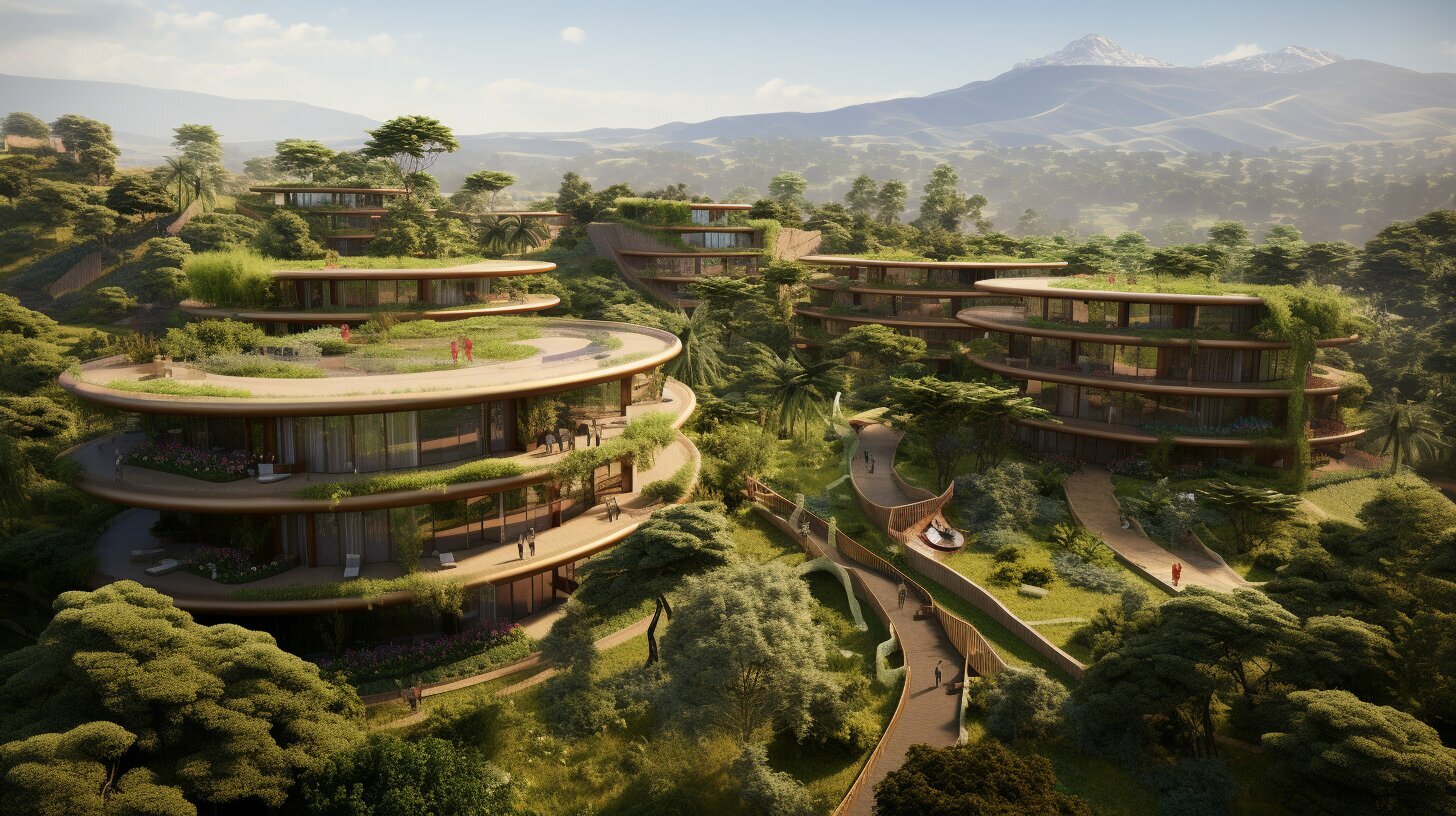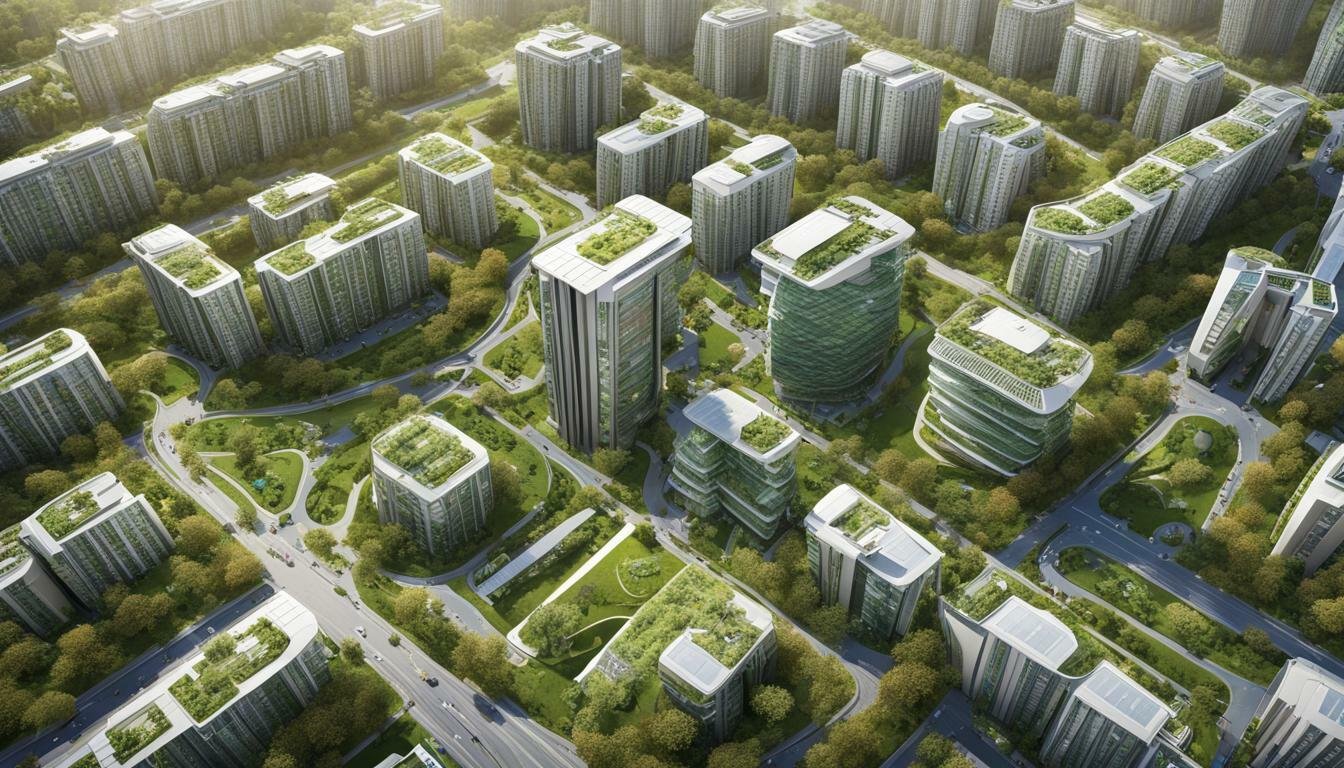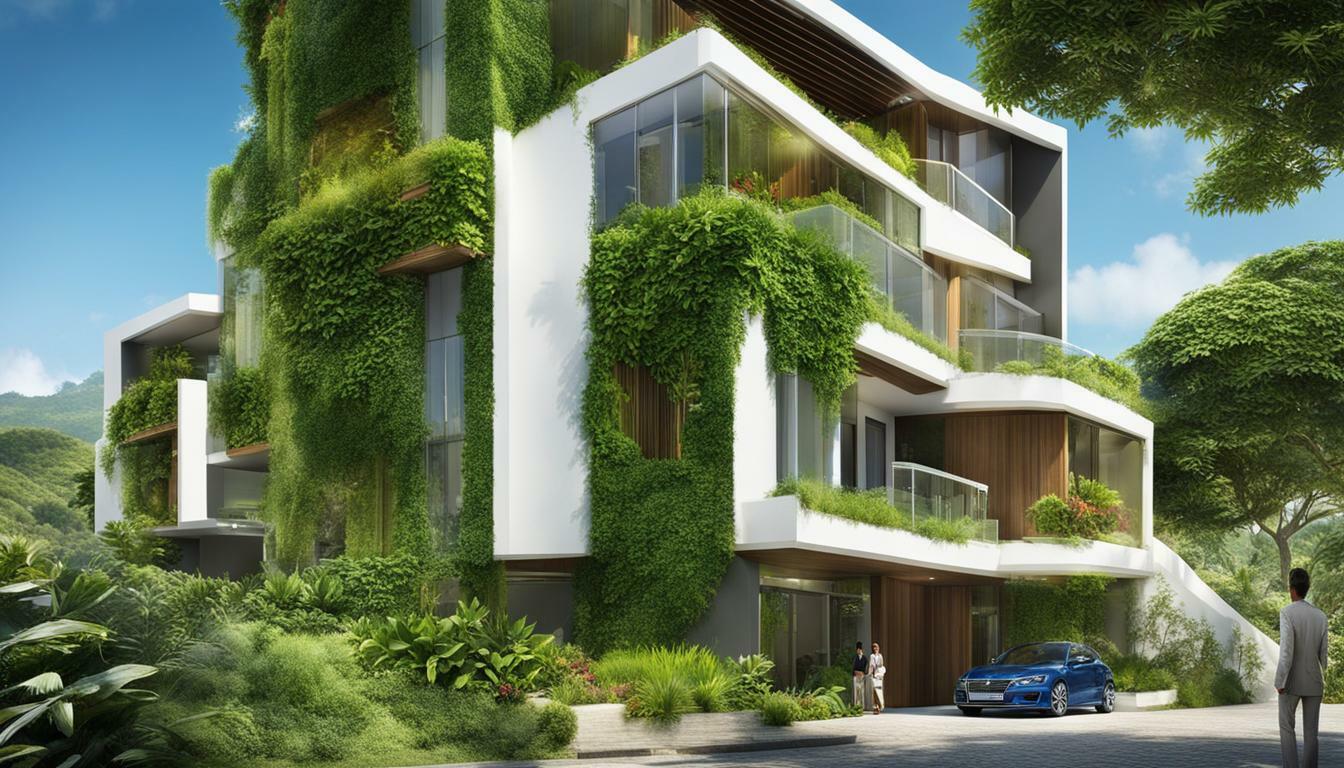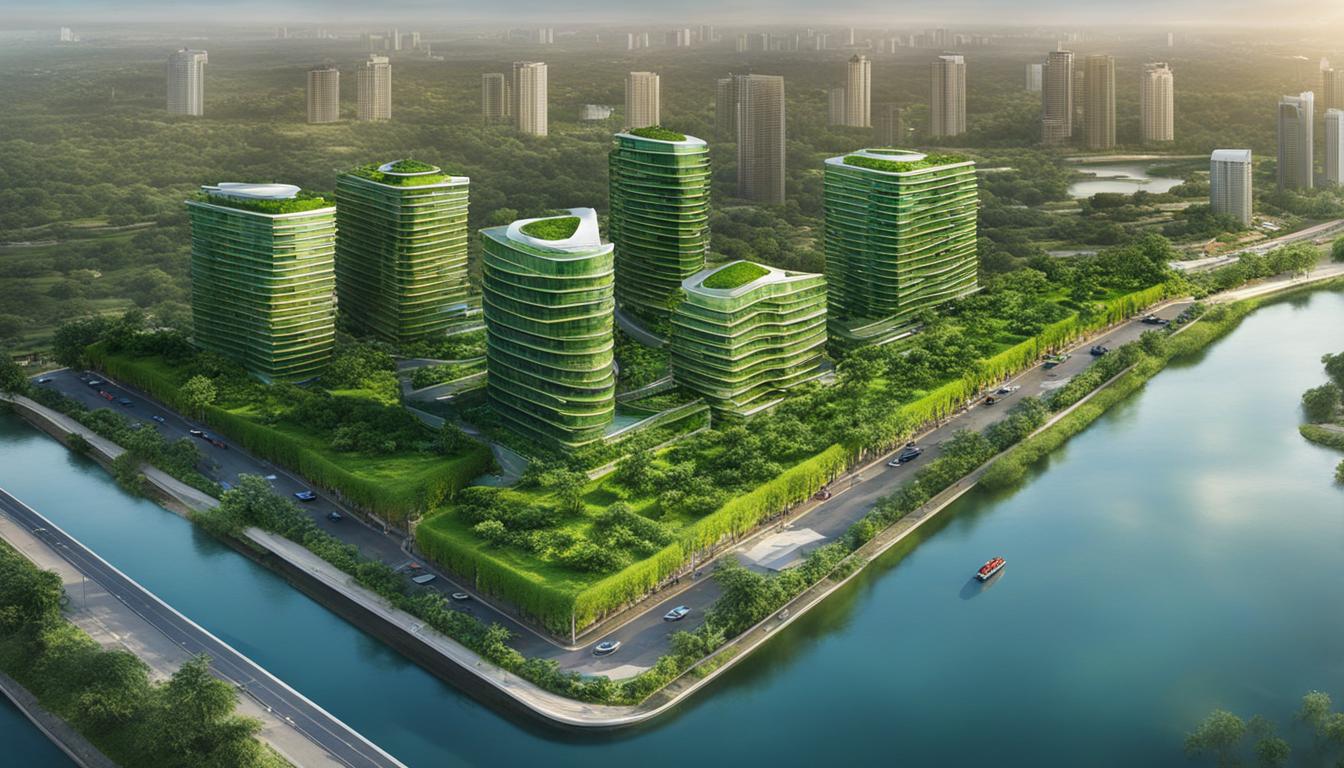Botswana Top Green Buildings Introduction
Botswana is making great strides in sustainable construction and eco-friendly design, with a focus on energy-efficient structures and environmentally friendly architecture. The country has taken significant steps towards promoting and implementing sustainable practices in the building industry. One notable achievement is the construction of the Motswere building, which is the first Green Star-rated office building in Botswana.
Key Takeaways:
- Botswana is committed to sustainable and environmentally-friendly practices in the building industry.
- The Motswere building is the first Green Star-rated office building in Botswana.
- It incorporates high levels of energy and water efficiency, as well as advanced building management systems.
- The building maximizes on daylight to reduce the need for electrical lighting.
- Botswana Green Building Council (BotGBC) works towards promoting and enabling the green building transformation in the country.
The Motswere Building – A Green Star-rated Office Building
The Motswere building, part of the Prime Plaza development in Gaborone, is a pioneering example of green building design in Botswana. Designed by Paul Munnik Architects, this impressive structure sets a new standard for sustainable and environmentally friendly architecture in the country.
Receiving a five-star Green Star Africa – Office Design v1.1 rating from the Green Building Council of South Africa, the Motswere building has been recognized for its commitment to energy and water efficiency. The building incorporates state-of-the-art mechanical ventilation and building management systems to minimize energy consumption and maximize occupant comfort.
One of the standout features of the Motswere building is its emphasis on natural daylight optimization. By strategically positioning windows and skylights, the building reduces the need for electrical lighting, resulting in significant energy savings. Additionally, the use of low volatile organic compound materials and the availability of preferential parking for fuel-efficient transport further contribute to its eco-conscious design.
“The Motswere building is a testament to Botswana’s dedication to sustainable practices in the building industry. It showcases the potential for green buildings to not only reduce environmental impact but also create healthier and more comfortable spaces for occupants.”

Despite facing challenges, such as the 2020 lockdown, which forced project team meetings to be conducted online, the Motswere building was successfully completed with unwavering dedication and seamless teamwork. This achievement further demonstrates Botswana’s commitment to sustainable development and sets an inspiring example for future green building projects in the country.
The construction of the Motswere building highlights the important role that green building councils, such as the Green Building Council of South Africa and the Botswana Green Building Council, play in promoting and facilitating sustainable architecture in Botswana. These organizations provide guidance, certifications, and resources to drive the adoption of eco-conscious practices in the building industry.
Green Building Councils and Sustainable Development
The Green Building Council of South Africa (GBCSA) is actively supporting the growth of green buildings throughout Africa. Its vision is to promote environmentally responsible buildings and spaces that improve lives and address climate change. The GBCSA believes that green buildings offer economic opportunities while contributing to a more sustainable future.
In Botswana, the Botswana Green Building Council (BotGBC) is playing a vital role in promoting, facilitating, and enabling the green building transformation agenda in the country. As part of the Technical Working Group with the Botswana Bureau of Standards, the BotGBC is actively involved in the development of energy standards and building codes in Botswana. Moreover, the BotGBC is a member of the Africa Green Building Council Outreach Committee, which aims to drive the adoption of green building concepts across the region.
| Key Points | Benefits |
|---|---|
| Incorporating energy-efficient systems | Reduced energy consumption and operational costs |
| Maximizing natural daylight | Improved occupant well-being and productivity |
| Using sustainable materials | Reduced environmental impact and improved indoor air quality |
| Promoting fuel-efficient transport | Encourages sustainable commuting and reduces carbon emissions |
The development of green buildings, such as the Motswere building, signifies a significant shift towards more sustainable practices in Botswana’s building industry. It serves as a reminder that sustainable architecture not only benefits the environment but also creates healthier and more comfortable spaces for individuals and communities to thrive.
Features of the Motswere Building
Designed by Paul Munnik Architects, the Motswere building incorporates a wide range of sustainable building materials and energy-saving techniques. This commitment to eco-friendly construction practices ensures that the building minimizes its environmental impact while maximizing its efficiency and functionality.
One key feature of the Motswere building is its use of sustainable building materials. From the foundation to the finishing touches, materials such as recycled steel, FSC-certified timber, and low volatile organic compound (VOC) paints and sealants were carefully selected. These materials not only reduce the building’s carbon footprint but also create a healthier indoor environment for its occupants.
In addition to sustainable materials, the Motswere building utilizes energy-saving techniques to reduce its energy consumption. It incorporates state-of-the-art mechanical ventilation systems, LED lighting with motion sensors, and a building management system that optimizes energy usage. By implementing these strategies, the building significantly lowers its energy demand and contributes to a more sustainable future.
The Motswere building also prioritizes natural daylight optimization. Large windows and skylights allow for ample natural light to enter the building, reducing the need for electric lighting during the day. This not only saves energy but also creates a pleasant and productive work environment for occupants. Furthermore, the building includes shading devices to prevent excessive heat gain, ensuring thermal comfort throughout the year.

Energy and Water Efficiency in the Motswere Building
The Motswere building prioritizes energy and water efficiency, setting a benchmark for sustainable construction practices in Botswana. Designed by Paul Munnik Architects, this landmark building incorporates various features and technologies that minimize its environmental impact while maximizing its resource efficiency.
One of the key strategies employed in the Motswere building is the use of energy-efficient structures and sustainable building materials. The building’s design and construction process prioritized the selection of materials with low embodied energy, such as recycled and locally sourced materials. By utilizing these sustainable materials, the Motswere building reduces its carbon footprint and contributes to a healthier indoor environment for its occupants.
Furthermore, the Motswere building implements energy-saving techniques throughout its operations. State-of-the-art mechanical ventilation and building management systems are employed to optimize energy use, ensuring efficient heating, cooling, and ventilation. Additionally, the building maximizes the utilization of natural daylight, reducing the dependence on electrical lighting and further decreasing energy consumption.
In terms of water efficiency, the Motswere building incorporates various water-saving features, including low-flow fixtures and water-efficient landscaping. The building’s design also includes rainwater harvesting systems to collect and reuse water for irrigation and other non-potable purposes. These initiatives not only reduce water consumption and conserve this valuable resource but also contribute to the sustainable management of water in Botswana.
| Features of Energy and Water Efficiency in the Motswere Building: |
|---|
| Use of energy-efficient structures and sustainable building materials |
| State-of-the-art mechanical ventilation and building management systems |
| Optimization of natural daylight to reduce electrical lighting |
| Incorporation of water-saving fixtures and rainwater harvesting systems |
In conclusion, the Motswere building demonstrates Botswana’s commitment to sustainable construction practices. By prioritizing energy and water efficiency and incorporating innovative technologies and design elements, this building sets an example for future green building projects in the country. The Motswere building not only contributes to the reduction of greenhouse gas emissions but also promotes resource conservation and the creation of healthier and more environmentally friendly built environments in Botswana.

The Motswere building maximizes on daylight to create a more sustainable and energy-efficient environment, while also incorporating eco-friendly features. Designed by Paul Munnik Architects, this three-level A-grade office space in Gaborone, Botswana, embraces the principles of green building design and environmentally friendly architecture.
One of the key aspects of the Motswere building is its emphasis on daylight optimization. By strategically designing the layout and using materials that allow natural light to penetrate deep into the building, the need for artificial lighting is significantly reduced. This not only reduces energy consumption but also creates a more pleasant and productive work environment for occupants.
In addition to daylight optimization, the Motswere building incorporates various eco-friendly features. The use of sustainable building materials, such as low volatile organic compound (VOC) materials, helps minimize the negative impact on indoor air quality. These materials are not only better for the environment but also promote the health and well-being of the building’s occupants.
Furthermore, the Motswere building includes preferential parking for fuel-efficient transport, encouraging occupants to use environmentally friendly modes of transportation. This promotes sustainability beyond the building itself and contributes to reducing carbon emissions in the surrounding area.

| Eco-friendly Features of the Motswere Building | Benefits |
|---|---|
| Daylight Optimization | – Reduces reliance on artificial lighting – Creates a more productive work environment – Saves energy costs |
| Sustainable Building Materials | – Improves indoor air quality – Reduces negative impact on the environment – Promotes occupant health |
| Preferential Parking for Fuel-efficient Transport | – Encourages the use of eco-friendly transportation options – Reduces carbon emissions |
The Motswere building is a testament to Botswana’s commitment to sustainable architecture and eco-friendly construction. By prioritizing daylight optimization and incorporating environmentally friendly features, this green building sets an example for future developments in the country.
Overcoming Challenges and Successful Completion
Despite facing challenges, such as the 2020 lockdown, the Motswere building was completed successfully through the dedication and teamwork of the project team. The lockdown presented obstacles in terms of logistics, communication, and the coordination of construction activities. However, the project team quickly adapted to remote work and shifted their focus to virtual meetings and online collaboration tools.
The Motswere building project team embraced the challenge and maintained a high level of productivity throughout the lockdown period. They effectively coordinated with suppliers and contractors to ensure a steady flow of materials and resources, while adhering to strict health and safety guidelines. The team’s commitment to the project’s timeline and quality standards remained unwavering, resulting in the successful completion of the building.
During the construction process, the team also faced other hurdles such as weather delays and technical issues. However, their problem-solving skills and proactive approach allowed them to overcome these obstacles efficiently. The Motswere building stands as a testament to the resilience and determination of the project team, showcasing their ability to navigate challenges and deliver exceptional results.

| Challenges Faced | Solutions Implemented |
|---|---|
| 2020 lockdown restrictions | Shifted to remote work, virtual meetings, and online collaboration tools |
| Weather delays | Adjusted construction schedule and increased workforce during favorable weather conditions |
| Technical issues | Engaged experts and technicians to promptly resolve technical challenges |
The successful completion of the Motswere building in the face of various challenges is a testament to the resilience and expertise of the project team. Their ability to adapt, problem-solve, and collaborate effectively ensured the project’s progress and ultimate success. The achievement of this green building underscores Botswana’s commitment to sustainable architecture and eco-friendly construction practices, setting a positive example for the country’s building industry.
The Role of Green Building Councils
Green building councils play a crucial role in promoting and facilitating sustainable architecture and eco-conscious buildings in Botswana. These councils, such as the Green Building Council of South Africa (GBCSA) and the Botswana Green Building Council (BotGBC), provide a platform for collaboration and knowledge-sharing among industry professionals, government bodies, and other stakeholders.
The GBCSA, known for its expertise in green building certification, supports the growth of green buildings across Africa. It has certified projects in various African countries and believes that green buildings are essential for addressing climate change and unlocking new economic opportunities. Through their certification programs, the GBCSA sets standards and benchmarks for sustainable building practices, encouraging the development of environmentally-friendly structures.
In Botswana, the BotGBC is actively working towards promoting, facilitating, and enabling the green building transformation agenda. It collaborates with the Botswana Bureau of Standards to re-develop building standards, particularly in relation to energy standards. The BotGBC is also involved in regional initiatives, such as the Africa Green Building Council Outreach Committee, which aims to promote the adoption of green building concepts across the region.
Benefits of Green Building Councils
Green building councils provide numerous benefits to the building industry in Botswana. They act as advocates for sustainable practices, raising awareness about the importance of eco-conscious buildings and their positive impact on the environment. Through education and training programs, they equip professionals with the knowledge and skills needed to design and construct green buildings.
These councils also foster collaboration and networking opportunities, bringing together professionals from diverse backgrounds to share best practices, innovative ideas, and research findings. By promoting the use of sustainable materials, energy-saving techniques, and efficient building systems, green building councils contribute to the development of environmentally-friendly infrastructure in Botswana.
With the guidance and support of green building councils, Botswana is poised to make significant progress in sustainable architecture and green building development. By implementing eco-conscious practices and embracing green building principles, the country can create a more sustainable built environment for future generations.
| Green Building Council | Role and Impact |
|---|---|
| Green Building Council of South Africa (GBCSA) | Supports green building growth in Africa and certifies projects in various countries. Sets standards and benchmarks for sustainable building practices. |
| Botswana Green Building Council (BotGBC) | Promotes, facilitates, and enables the green building transformation agenda in Botswana. Collaborates with the Botswana Bureau of Standards and regional initiatives. |
According to the Green Building Council of South Africa, green buildings are part of Africa’s solution to climate change and can stimulate new economic opportunities. Through the efforts of green building councils and the commitment of industry professionals, Botswana is embracing sustainable practices in the building industry to create a greener and more environmentally-conscious future.

The development of green buildings in Botswana, exemplified by the Motswere building, signifies the growing awareness and commitment to sustainable architecture and eco-friendly construction practices in the country. Botswana is making strides in green building development, as demonstrated by the construction of the first Green Star-rated office building in the country.
The Motswere building, located in the Prime Plaza development in Gaborone, received a five-star Green Star Africa – Office Design v1.1 rating from the Green Building Council of South Africa. Designed by Paul Munnik Architects, this three-level office building incorporates high levels of energy and water efficiency, state-of-the-art mechanical ventilation, and building management systems.
One of the key features of the Motswere building is its emphasis on maximizing natural daylight to reduce the need for electrical lighting. It also includes eco-friendly features such as low volatile organic compound materials and preferential parking for fuel-efficient transport. Despite facing challenges, including the 2020 lockdown, the Motswere building was successfully completed, showcasing the dedication and teamwork of the project team.
The development of green buildings in Botswana is further supported by organizations such as the Green Building Council of South Africa and the Botswana Green Building Council. These councils promote and facilitate the adoption of sustainable practices in the building industry, working towards creating a greener future for Botswana. The commitment to green building not only showcases Botswana’s dedication to environmental sustainability but also presents new economic opportunities and contributes to the global effort in combating climate change.
FAQ
Q: What is the significance of the Motswere building being the first Green Star-rated office building in Botswana?
A: The Motswere building’s Green Star rating demonstrates Botswana’s commitment to sustainable and environmentally-friendly practices in the building industry.
Q: Who designed the Motswere building?
A: The Motswere building was designed by Paul Munnik Architects.
Q: What features does the Motswere building incorporate?
A: The Motswere building incorporates high levels of energy and water efficiency, state-of-the-art mechanical ventilation and building management systems, and maximizes on daylight to reduce the need for electrical lighting. It also includes low volatile organic compound materials and preferential parking for fuel-efficient transport.
Q: How did the Motswere building overcome challenges, such as the 2020 lockdown?
A: Despite facing challenges, the Motswere building was successfully completed with the dedication and teamwork of the project team.
Q: What is the role of green building councils in promoting sustainable architecture in Botswana?
A: Green building councils, such as the Green Building Council of South Africa and the Botswana Green Building Council, play a vital role in promoting, facilitating, and enabling the green building transformation agenda in Botswana.







